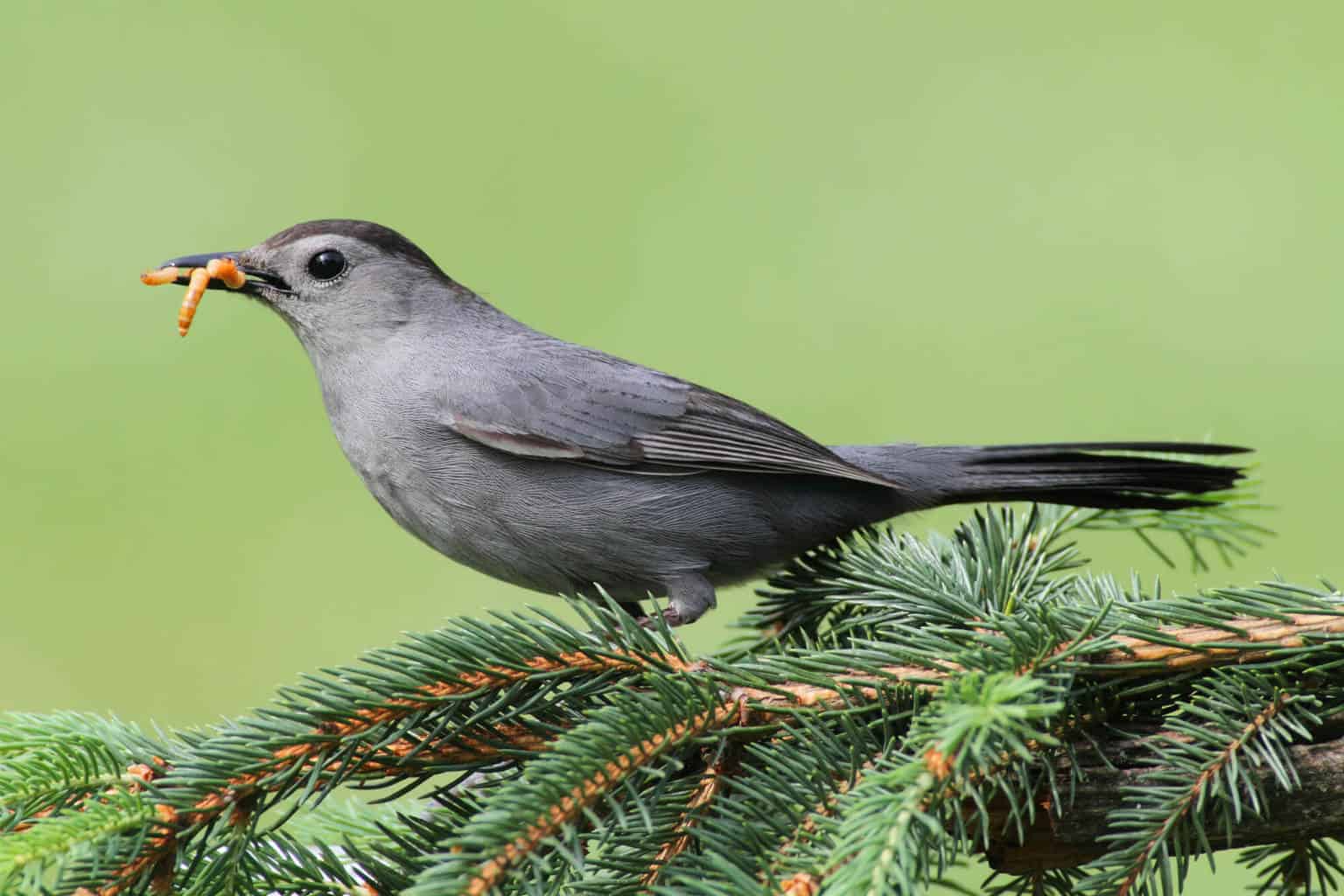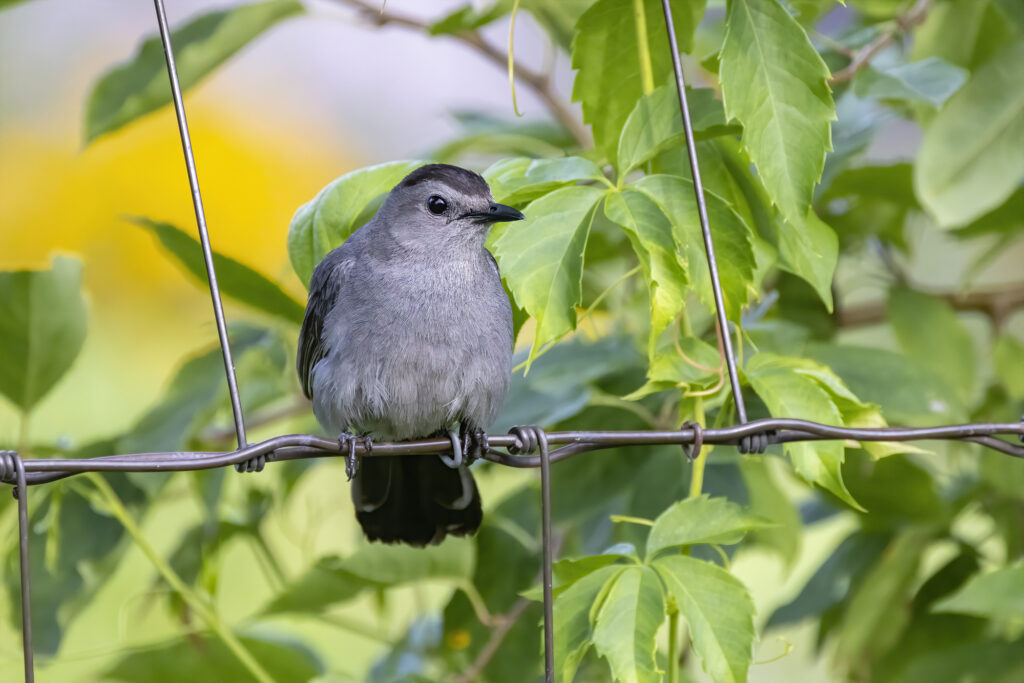Have you ever heard an animal sound that you can’t quite identify? Is that a kid? A bird? A cat? A creaking garden gate?
You may already know that birds are capable of sounding like many other creatures, including the barking owl that sounds like a dog and the lyrebird that sounds like a crying human baby.
Not all birds are mimics, but those who are capable of doing so will mimic machinery, human voices, other birds, and totally different animals.
What about meowing? Or howling like a cat in distress? Are there birds that make these sounds?
If you hear these sounds but know there are no cats around, you might be hearing the song of a catbird! In fact, many birders use catbirds as their introduction to identifying birds by sound because they have such a distinctive call.
The Gray Catbird: A Bird That Sounds Like a Cat
- Length: 8.5″
- Wingspan: 11″
- Weight: 1.3 oz
The Gray catbird is a medium-sized songbird with long legs, rounded wings, a straight bill, and a long black tail.
Many birds are sexually dimorphic, but catbirds are monomorphic. Sexual dimorphism means that the male and female of a species look distinct from one another. Sexually monomorphic birds look about the same, regardless of sex.
Male and female Gray catbirds are nearly indistinguishable from one another. They are about the same size and have the same coloration, feather shapes, and patterns. They also have similar behaviors.
Catbird Range
Some Gray catbirds live full-time as residential birds along the entire Atlantic Coast. However, many Gray catbirds migrate all over the US for their breeding season, except for the West Coast. If you’re in California, that’s not a catbird you hear!
They spend the winter along the Atlantic Coast of Mexico and Central America, as well as the Caribbean islands.
Gray Catbird Facts

Before we talk about the unique sounds that the Gray catbird makes, let’s look at some other interesting facts about these birds.
- The Gray catbird is the state bird of Tennesee.
- Not only do males and females look alike, but they also behave similarly. The female only needs to sit on her small clutch of eggs for about 14 days, and then both catbird parents feed their young.
- Gray catbirds have a complicated syrinx. That’s the voice box that allows birds to sing. Instead of just singing one note at once, Gray catbirds can sing two notes at the same time! (Another bird with a complex syrinx is the hummingbird.)
- Most songbirds can’t recognize the eggs of Brown-headed cowbirds in their nests. Brown-headed cowbirds commit brood parasitism, which means they lay their eggs in other birds’ nests. This allows them to produce many young without doing the work of incubating the eggs and raising the babies. Fascinatingly, the Gray catbird can recognize the difference between her own eggs and the cowbird’s eggs. She will push the intruder’s eggs out of her nest!
About That Voice: Why Do Catbirds Sound Like Cats?
Check out this video of the raspy mew of a catbird!
You can hear the way that the bird sounds like a cat. Close your eyes and listen, and you can hear that it would be easy to mix up a cat and a catbird!
Catbirds create this sound through mimicry. Other North American mimics include mockingbirds and thrashers. Starlings can mimic other birds as well as vehicle motors and heavy equipment, and blue jays imitate hawks!
The song a catbird makes consists of a series of rapid, short sounds. There may be up to 100 different syllables in a catbird’s song! They can whistle, chatter, squeak, and mew, and they will sing for several minutes at a time.
All of this makes catbirds one of the easiest birds to recognize by sound! Birders who are new to identifying birds by sound should definitely watch some catbird videos and listen to some catbird sounds. It will be quite easy to recognize these interesting little birds!
Because of how easy it is to identify a catbird by sound, it’s also a great way to introduce kids to birding by ear.
If you want to confirm that you’re hearing a catbird, you could also use the Merlin app by the Cornell Lab of Ornithology. It has a useful “identify by sound feature,” where you can record audio of a bird in real-time and get an immediate list of suggestions of what it is.
What Other Birds Make a Sound Like a Cat?
Catbirds are the main culprit of making cat sounds, but owls are another possibility! Great horned owls make a meowing sound that can be described as cat-like.
Here is a video with some of the distinctive sounds of a Great horned owl. Some birders have also reported that they have heard starlings making cat sounds.
Of course, parrots mimic all kinds of sounds that they encounter in their daily lives, and that includes family pets like cats.
Here’s a video of a cockatoo meowing like the family’s pet cats.
Why Do Some Birds Mimic Other Animals, Including Cats?
There are many reasons why a bird might mimic another animal. We have good explanations for some mimicry and less complete explanations for other mimicking behaviors.
Presumably, mimics have a reason for trying to sound like other birds – we just haven’t figured all of that out quite yet!
Sometimes, they are trying to distract a predator. Other times, their sound is a disguise. They may make unusual noises in their attempts to impress a potential mate.
Baby birds that inhabit the nests of other species have been known to adopt the bird sounds of the species in their nest; it helps them go unnoticed by their new parents! Nobody wants to be perceived as an intruder, after all.
How Do You Know It’s Not a Cat?
The catbird doesn’t usually make a cat sound without making a lot of other sounds, too. The sound of a cat meowing will typically be accompanied by lots of other notes, syllables, and songs.
If you are trying to determine if that’s a catbird or a distressed cat or kitten that you hear, pause to determine if the animal is making multiple sounds or just one. A kitten or cat will stick with a pretty small range of vocalizations, but the catbird will hit multiple notes, sounds, and syllables, all within a short period of time.
Where Can You Find Catbirds?
Where should you listen out for catbirds? Because the Gray catbird is found throughout most of the United States, most people in the US will have the opportunity to listen to catbirds if they go out looking.
They can be found in dense thickets and in small trees with lots of leaf cover. They like vines, forests, rivers and streams, fields, and fences.
They blend into their surroundings well, so you will probably hear a catbird before you see it!
What Kind of Bird Sounds Like a Cat in Distress?
Similar to a Gray catbird, the Green catbird in Australia also sounds quite cat-like! You can hear in this video how the Green catbird sounds like a cat in distress.
They live in subtropical forests that can be found along the east coast of Australia. That includes the range between southeastern Queensland and southern New South Wales.
Interestingly, the call of a Green catbird has also been described as similar to that of a crying child!
Green catbirds are not related to Gray catbirds, even though they share a similar name. Gray catbirds are part of the Mimid family, whereas Green catbirds are Bowerbirds.
Other Kinds of Catbirds
Several other catbirds live in Australia and around the world. Catbirds are not necessarily related to one another, although several are Bowerbirds.
Bowerbirds are known for their fascinating courtship behavior! Males build “bowers” of sticks and twigs. These bowers are created by two upright walls that curve together at the top and leave a hole in the middle. Then, the males decorate these bowers with all kinds of treasures!
A male bowerbird, working to impress a potential mate, will fill his bower with flowers, colorful pieces of plastic and trash, berries, and feathers. The bower of a Satin bowerbird is especially easy to spot: he will have only collected blue items!
Blue plasticware, blue bottle caps, blue feathers, blue pen caps, blue string, blue hair ties, and more. If it’s blue, the Satin bowerbird would love to include it in his bower!
All of these catbirds get their name from the fact that their call is cat-like.
Catbird species include:
- The Black catbird, which lives in the Yucatan Peninsula in Mexico
- The Spotted catbird, which lives in north Queensland, eastern Moluccas, and also Papua New Guinea
- The Abyssinian catbird, which lives in the tropics of Ethiopia
- The Tooth-billed bowerbird, which lives in northeast Queensland
- The White-eared catbird, which lives in Indonesia and Papua New Guinea
One convenient fact is that because most of these birds live far from one another and never share territory, you can easily determine what kind of catbird you are hearing based on where you are located.
If you hear a cat-sounding bird in North America, it is going to be a Gray catbird. If you hear one in Ethiopia, it must be the Abyssinian catbird. And if you are in Australia, you should consult a territory map to see which catbird you might be hearing!

